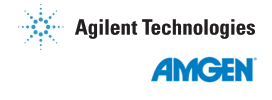High-throughput mass spectrometric analysis of covalent protein-inhibitor adducts for the discovery of irreversible inhibitors: a complete workflow
 Part 1 of our webinar series on high-throughput mass spectrometry in drug lead discovery
Part 1 of our webinar series on high-throughput mass spectrometry in drug lead discovery
We have implemented a SPE-based RapidFireTM (Agilent) TOF-MS system in combination with novel informatics to rapidly screen and characterize the covalent binding of different irreversible inhibitors to intact proteins. This high-throughput screening (HTS)-MS platform can be used to accurately detect and quantitate the extent of formation of different covalent protein-inhibitor adducts between electrophilic inhibitors and nucleophilic residues such as cysteine, lysine, or histidine of intact proteins. A key element of the workflow is the automated identification and quantitation of the expected masses of covalent protein-inhibitor adducts using a custom PipeLine Pilot (Accelrys) script, which obviates the need to manually inspect each individual spectra. Together, this high-throughput SPE-MS and data analysis system has the capacity to test and analyze thousands of samples in a relatively short time, enabling the screening of libraries of reactive compounds or use in a weekly medicinal chemistry covalent inhibitor lead optimization cycle. Parallel screens were performed on a library of approximately 1000 acrylamide-containing compounds of different structures and reactivities using both this SPE-MS based assay and a fluorescence-based thiol-reactive probe assay, enabling comparison of false positives and false negatives between these orthogonal screening approaches.
What will you learn?
- How to rapidly screen libraries of thousands of reactive compounds against a target protein using mass spectrometry in a weekly medicinal chemistry lead optimization cycle
- How to implement a protein SPE based RapidFireTM TOF-MS for high-throughput screening
- How to automate the hit identification and quantitation workflow using a custom PipeLine Pilot (Accelrys) script
Who may this interest?
- Lead discovery researchers directly engaged in conducting hit screening
- Lab managers and scientists focused on identifying hits against disease targets in academia, startups, Biotechnology, Pharmaceutical companies and CROs
- Project leaders, medicinal chemists and biologists interested in identifying high quality hits to drive their drug discovery programs forward
- Mass spectrometrists, automation experts and analytical chemists working in pharmaceutical research
- Academicians and students interested in pharmaceutical drug discovery
Speakers
 Iain Campuzano
Iain Campuzano
Senior Scientist
Amgen
Iain Campuzano obtained his PhD from the University of Southampton (UK) in protein chemistry and biological mass spectrometry in 1998. He worked at Servier R&D (UK) until August 2000, in the DMPK Department, performing small molecule LC-MS. He worked at Waters Corporation (UK) in the demonstration and R&D application laboratories until March 2011. He moved to Amgen (CA, USA) and works in the Department of Molecular Structure and Characterization, where he supports early research projects such as the medicinal chemistry small molecule synthesis effort and all therapeutic areas, by using mass spectrometry. He is the inventor/co-inventor of 4 MS-related patents and author/co-author of over 40 peer-reviewed scientific articles. He regularly presents at and supports international conferences, such as ASMS and PITTCON.
Vaughn Miller
Application Scientist
Agilent Technologies
Vaughn Miller received his PhD in Biological Chemistry from the University of Minnesota (USA) followed by postdoctoral training in the department of Pharmaceutical Chemistry at University of California, San Francisco. Vaughn has more than 20 years of experience in the research, development and commercialization of life science research products. Vaughn has led product development; marketing and sales teams focused on innovative drug metabolism, drug discovery and bioanalytical technologies at Gentest Corporation, Becton Dickinson and Agilent Technologies.
Click here to view the Q&A follow-up.
For information on the second webinar in this series please see here and for a full list of other webinars available on Bioanalysis Zone please see here.

